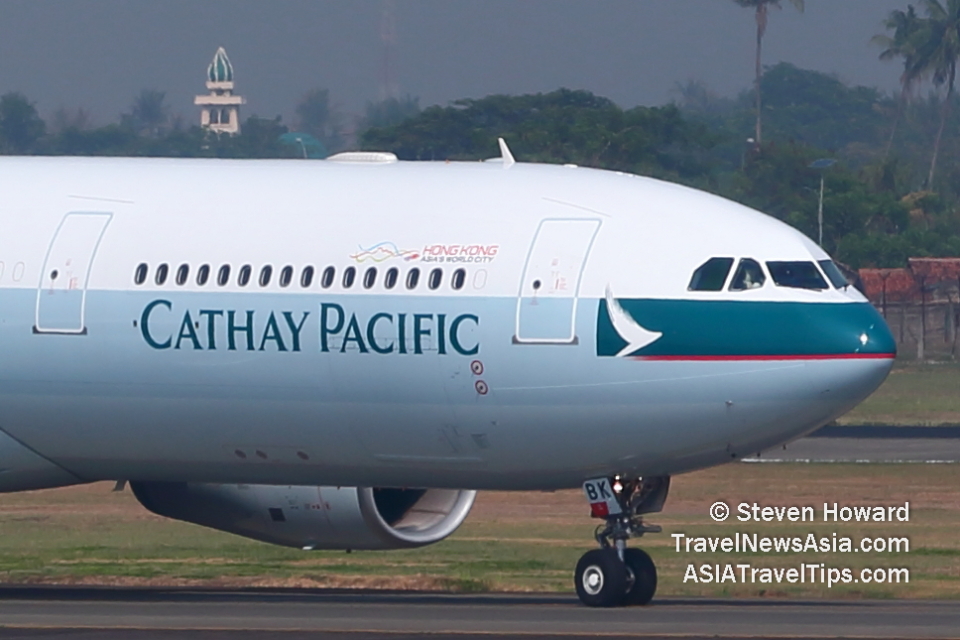|
(18 Feb 2022)
Cathay Pacific carried 24,699 passengers in
January 2022, a decrease of 18.8% compared to January 2021, and a
99.2% decrease compared to the pre-pandemic level in January 2019.
The month�s revenue passenger kilometres (RPKs)
decreased 23.4% year-on-year, down 99% on January 2019. The
passenger load factor increased by 27.1 percentage points to
40.3%, while capacity, measured in available seat kilometres
(ASKs), decreased by 74.8% year-on-year, a drop of 97.9% compared
with January 2019 levels.
Ronald Lam, Cathay Pacific's Chief Customer and Commercial Officer,
said, �We�ve had a very difficult start to 2022 with the
accelerated spread of the Omicron variant and the further
tightening of travel and operational restrictions, notably
stricter quarantine requirements for Hong Kong-based aircrew. As a
result, Cathay Pacific�s passenger flight capacity in January
reduced by about 82% compared with December 2021, to about 2.1% of
pre-COVID19 levels. Meanwhile, passenger numbers dropped to an
average of 797 per day. Load factor was about 40%.

Cathay Pacific A330 reg: B-LBK. Picture by Steven Howard of TravelNewsAsia.com
�Both inbound and transit traffic were limited by
the enhanced restrictions imposed by the Hong Kong SAR Government,
while outbound demand also remained weak. Passenger traffic in
January was largely generated from ex-Chinese Mainland flights via
the Hong Kong hub to long-haul destinations in Australia, the US
and the UK. We also saw some pre-Lunar New Year traffic between
the Chinese Mainland and Hong Kong.
�In light of the additional quarantine measures
imposed on Hong Kong-based aircrew, our cargo flight capacity in
January reduced by about 69% compared with December 2021, to about
21% of pre-COVID19 levels. This reduction was felt most acutely
on our long-haul frequencies, where in the first week of January
we had to cancel all such services for seven days while reviewing
our crew rostering arrangements. Since then, we have only been
able to mount limited freighter flights to the Americas, while the
shipment of goods to Europe, the Middle East and Southwest Pacific
is being provided by passenger aircraft carrying only cargo.
�Our regional operations remained intact and, as
such, our teams were able to place added focus on opportunities in
the Chinese Mainland and the region. This resulted in increased
cargo capacity for services to destinations in Northeast Asia and
the Indian subcontinent where there was good demand prior to the
Lunar New Year holidays.�
The airline carried 74,242 tonnes of cargo in
January, a decrease of 31.8% compared to January 2021, and a 55.5%
drop compared with the same period in 2019.
The month�s cargo
revenue tonne kilometres (RFTKs) decreased 64.4% year-on-year, down 73.6% compared to January 2019.
The cargo load factor
decreased by 2.8 percentage points to 76.6%, while capacity,
measured in available cargo tonne kilometres (AFTKs), was down by
63.1% year-on-year, down by 78.8% versus January 2019.
Looking ahead, Mr. Lam said, �In February and beyond, we will
continue to operate a highly reduced passenger flight schedule
until at least the end of March in view of the extension of
quarantine measures for Hong Kong-based aircrew, the
flight-specific and place-specific suspension mechanism as well as
the transit ban by the Hong Kong SAR Government. We will continue
to strive to maintain passenger connectivity to key destinations
as much as possible, although we are currently not seeing any
signs of significant recovery in passenger travel demand. We
expect to continue operating about 2% of our pre-COVID-19
passenger flight capacity while current restrictions remain in
place.
�Regarding cargo, demand during the first half of
February was affected by the reduced production over the Lunar New
Year holiday period, though it is expected to progressively
improve during the second half of the month. In light of the
ongoing strict crew quarantine requirements, we will continue to
operate a reduced schedule for our long-haul cargo operations,
with services to Europe and the Middle East continuing to be
served by passenger aircraft carrying cargo only, while
trans-Pacific frequencies will remain similar to January. However,
we have managed to restore some freighter frequencies to the
Southwest Pacific and we will continue to maximise opportunities
provided by our regional markets. Overall, our cargo flight
capacity is likely to remain less than one-third of pre-COVID-19
levels in the first quarter.
�We are also continuing to support Hong Kong�s
fight against the pandemic with critical supplies of medical
products. In addition to COVID-19 vaccines, we have shipped more
than five million Rapid Antigen Test (RAT) kits (190 tonnes) from
the Chinese Mainland this week, with more to come.�
|
Headlines: |
|
|
